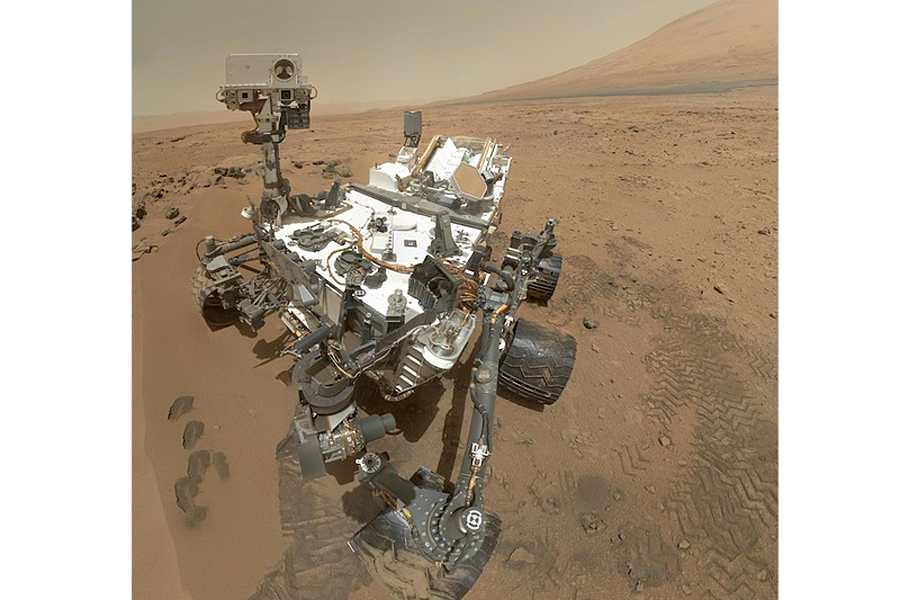Robots laying important groundwork for manned Mars misisons
Loading...
Whenever humans finally touch down on Mars, they'll be following in the footsteps of many brave robotic pioneers.
Right now there are two NASA robots exploring the Martian surface — the Curiosity rover and its older cousin, Opportunity — while a fleet of orbiters from NASA and the European Space Agency circle above. More probes are on the way, too.
With each landing on the Red Planet over the past three decades, the understanding of how to get safely to the surface has improved. Bigger probes require new technologies, such as the rocket-powered "sky crane" that lowered the 1-ton Curiosity rover onto the Red Planet on cables in August 2012. [The Boldest Mars Missions in History]
A human landing on the surface, however, would require a much heavier spacecraft. One key to designing it is to better understand winds high in the Martian atmosphere. NASA's Mars InSight lander, which is slated to blast off in 2016, and the agency's Mars 2020 rover will both examine gusts in that region, said Victoria Friedensen, NASA's robotic precursor mission lead.
"We have nearly all the information we need to really design the system we can put [humans] in," she told Space.com. A safety margin in landing heavier missions on the Red Planet is one of the chief concerns that NASA has right now, she added.
Science and human exploration goals
Getting people to Mars is the chief long-term goal of NASA's human spaceflight program. After all, President Obama directed the space agency to send astronauts to the vicinity of the Red Planet by the mid-2030s.
NASA is developing a crew capsule called Orion and the Space Launch System mega-rocket to get the job done. The pair, which is slated to fly together for the first time in 2021, will be able to get astronauts to a variety of deep-space destinations, agency officials say.
Sending robotic probes to Mars is a relatively cheap and low-risk way to show the way for humans, Friedensen pointed out. For example, NASA's unmanned Lunar Ranger series in the 1960s helped mission planners of the day learn about the nature of the moon's dusty surface.
At the time, a few scientists were worried that a spaceship would sink deep into the lunar dust. The robotic spacecraft showed that wouldn't happen, helping pave the way for the manned Apollo moon missions.
The Curiosity's rover main goal is to characterize the habitability of Mars' surface in general, but that also includes some information that could be relevant for human missions.
Curiosity's Radiation Assessment Detector instrument, for example, could inform designs of radiation shielding for a potential Mars colony. And analyzing the water concentration in the regolith or soil of Mars could help planners design extraction systems for thirsty human colonists.
Landing sites must also be considered carefully. The science goals of NASA's Mars Reconnaissance Orbiter include studying water's history on the Red Planet and examining small features on the surface. Its high-resolution images, however, also will help mission planners scout out suitable locations for a human landing, Friedensen said.
'Critical mass' of Mars mission support
While science missions have persisted for decades, space policy tends to change quickly — which could account for what some see as the slow and inconsistent progress toward human exploration of Mars, said Chris Carberry, executive director and co-founder of the nonprofit organization Explore Mars.
A recent example was the Vision For Space Exploration, a George W. Bush-backed initiative that would have seen astronauts heading back to the moon and on to Mars. It was cancelled after President Barack Obama took office in 2009 in favor of a "flexible destination" approach to space.
Lately, Carberry added, he has seen more "unity" in Congress, the space community and the general public toward a mission to Mars.
"I think many of the key policy elements are in place to move forward if we choose to move forward," he said. The key, he added, will be showing a "critical mass" of support during the next presidential election in 2016 so that Mars is not framed as an expensive and negative policy decision.
Friedensen and Carberry both gave talks at the Humans to Mars Summit April 22-24 in Washington, D.C.
Follow Elizabeth Howell @howellspace, or Space.com @Spacedotcom. We're also on Facebook and Google+. Original article on Space.com.
- Mars Myths & Misconceptions: Quiz
- Mars Explored: Landers and Rovers Since 1971 (Infographic)
- 7 Biggest Mysteries of Mars
Copyright 2014 SPACE.com, a TechMediaNetwork company. All rights reserved. This material may not be published, broadcast, rewritten or redistributed.







